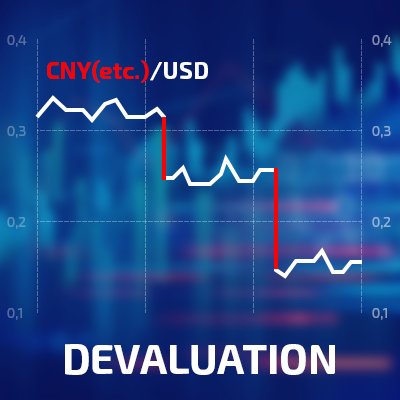
Until now, many often confuse devaluation with inflation, despite the characteristic difference between them. Let’s look at what devaluation means.

Until now, many often confuse devaluation with inflation, despite the characteristic difference between them. Let’s look at what devaluation means.
Devaluation - depreciation of the national currency against foreign exchange rates.
Initially, the value of the currency of most countries was tied to gold (the gold standard), but in the second half of the 20th century, everything changed under the influence of various macroeconomic factors. Now the exchange rate of national currencies is increasingly tied to the US dollar or euro, which many states hold in reserve. The depreciation of the state currency against foreign exchange rates in the reserve, that is, the hardest currencies, is called devaluation.
The government is applying devaluation techniques to somehow affect the entire economy. For example, this directly affects oil prices. Or, if the devaluation comes with state support for producers within the country, then the growth in purchases of domestic goods is inevitable.
It is important to note that devaluation does not mean a crisis. This process is often carried out by states of different countries in order to adjust the current economic direction.
Despite the fact that inflation and devaluation are often equated and the fact that they have a connection with each other is different.
That is, during devaluation, one can observe an increase in the exchange rate at exchange points, and with inflation, an increase in prices for goods in stores.
There is also a devaluation-inflationary spiral. This is a process that is one of the consequences of devaluation. It happens, for example, if in a country that is heavily reliant on imports, its prices rise sharply. The government is trying to contain changes in the economy through devaluation, but there is a crisis that causes inflation and a new devaluation - next.
Devaluation is usually divided into several main types:
It is accompanied by official recognition by the central bank of the country of the fact of depreciation of the national currency. The process is abrupt, new rates are being established at exchange points.
Depreciating cash is withdrawn from circulation for a long time. This process is usually invisible to the public. No official statements are made. This process can provoke inflation, but it also allows domestic producers of goods to adjust to the change in rates and begin to compete with foreign manufacturers.
The central bank of the country takes measures to curb the depreciation of the national currency within a limited period of time.
The most common type of devaluation. The depreciation of the national currency is not restrained by anything and measures to minimize the damage from this have no effect.
There are many reasons for devaluation. There are many macroeconomic factors that are the main source of influence in the beginning of the process of depreciation of the national currency, therefore the classification of reasons is relatively conditional. However, there are a number of reasons that cannot be ignored:
The devaluation is not necessarily a consequence of the crisis, the consequences of its implementation can vary greatly. There are both pros and cons from devaluation,.
Pros:
Cons:
Not only the country's budget benefits from the devaluation process itself. Agricultural companies, travel companies, export companies - they also profit from devaluation. And, of course, all the citizens of the country who keep their savings in foreign currency, who picked the right moment and exchanged their money to make a decent profit.